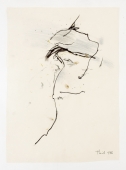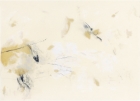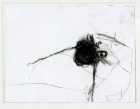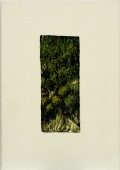
Artist | Dan Flavin (1933 - 1996)
https://www.artist-info.com/artist/Dan-Flavin
Biography
Biography
born in 1933
About the work (english / deutsch)
About the work (english / deutsch)
Two Primary Series And One Secondary
Two Primary Series And One Secondary is a light installation Flavin created in 1968 for the three adjacent exhibition rooms in the then Heiner Friedrich Gallery in Munich. It consists of a total of nine sections, which are subdivided into three groups of three. The three sections of each group consist respectively of one element of two, one of four and one of six neon tubes. In each of the elements half of the tubes are red, the other half yellow, in the next element half blue, and in the last element half green. All the neon tubes are positioned vertically and are staggered in height: the red tubes start either in the middle of a group or above the tubes in the other colors. Thus each group is made up of an arrangement of three dichromatic elements, which are assembled by simply progressively staggering identical modular forms.
Flavin's concept, which he outlined in drawings, involves placing the three groups of elements in the three exhibition rooms in the following sequence: red-yellow, red-blue and red-green, the individual elements being positioned vertically and in a rhythmic progression in each color group. Flavin then decided on site what the respective arrangement of the elements on the walls of the rooms would be. In the Heiner Friedrich Gallery the three groups of elements were spread across one larger and almost square middle room and two narrower rooms on either side. He then placed the individual elements partly in the middle und partly in the corners of the walls. The presence of a number of windows meant that the situation changed daily alternating intensive daylight and the different colors of the artificial light.
For the MMK installation, Flavin developed a differentiated concept which again takes account of the specific spatial setting. He has distributed the three groups of elements across three adjacent exhibition rooms that are identical in size and ground plan. He starts with the three sections consisting of red and yellow tubes; the next room contains the three red and blue sections and the third room the red and green tubes. The elements are mounted in the middle of the walls in all the rooms, starting at the left with the smallest element. The two other sections then follow progressively, so that the colors become more intense toward the right wall in each of the rooms.
The title of the installation Two Primary Series And One Secondary refers above all to the intrinsic value of the colors in connection with chromatic laws of a color chart and at the same time offers an explanation for the distribution of color in the exhibition rooms. Together with red, the colors yellow and blue are primary colors. Red/yellow and red/blue are thus primary series and are spread across the first two rooms. Green is a secondary color, derived from simply mixing the two primary colors yellow and blue. The combination red/green is therefore a secondary series and is placed on its own in the third room. The color red, on the one hand, relates all the rooms to one another in terms of the aesthetic perception we have of them and, on the other, enables us to experience the different intrinsic values und effects of yellow, blue and green as colors.
The title of the work refers not only to the interlinking of the colors, but also alludes to principles of mathematical order that derive from elementary constellations. The first and most fundamental elementary constellation, the first primary series, consists respectively of a red und a yellow, blue or green neon tube, with the lowest tube being yellow, blue or gree und the tube starting in the middle to the left of these always being red. The second primary series is by contrast a combination respectively of two red tubes und two tubes in other colors. Here, the two red tubes are positioned directly at the uppermost end of the two vertical sequences of yellow, blue and green tubes. This arrangement cannot be formally derived from the first order; it thus possesses an equal status and can be juxtaposed to the latter. The third constellation of tubes consists respectively of three red neon tubes und three tubes in other colors, and can either be derived from the first sequence or from the first and second sequences: it can consequently be termed a seconda series. On entering the rooms flooded with fluorescent light one after the other, you immediately feel yourself transported into a different, unnatural, "artificial" world. However, as the pure color effects generated by the neon tubes are not to be encountered in nature, you encounter an unusual aesthetic experience. Initially, owing to the contrasting light and shadows they create, the neon tubes with their different colors take on the concrete form of sources of light that shed an ever weaker, diffuse light an the room. As a result of the various physiological reactions triggered - these affect the process of perception - after a short phase of perceiving the rooms as bathed in pure color, you start to register the rooms as changing, colored experiential zones, zones that, even if you repeat the process of perception do not lose any of their character as series of events. For, as a consequence of the combinations of colors, the colors red and yellow appear briefly to be orange, with red und blue also appearing for a short time as violet and red and green merge briefly into brown. Owing to the complementary contrast, after saturation in a color, the eye forms the corresponding contrasting color, so that the room is then steepe in virtual, changing hues. If, on leaving the rooms with the light installation, you subsequently gaze at a white wall, this appears for a time to be imbued with complementary color tones owing to the successive contrasts the eye has perceived.
Flavin's light installations constitute a complete change of spatial and aesthetic conditions. The proportions, dimensions and material qualities of walls, ceilings, corners and floors appear transformed. For the duration of the process of perception the concrete existence of a room becomes a relative, experiential category, a variable factor. Flavin thus opens up the architectonic interior for an inquiry into perception, reflection and being. It is him we have to thank for the fact that artists, designers and custodians now have a sharper eye for the basic conditions of a space, a room or an exhibition hall. "The room" has consequently become a substantive, atmospheric and creative variable, not just in museums, but also in the private und public domains.
German text by Rolf Lauter / Translation by Jeremy Gaines
(Extract - Full printed version available in the Museum)
MMK - Museum für Moderne Kunst, Frankfurt am Main
Two Primary Series And One Secondary
Two Primary Series And One Secondary ist eine Lichtinstallation, die Flavin im Jahr 1968 für die drei nebeneinanderliegenden Ausstellungsräume der damals noch existierenden Galerie von Heiner Friedrich in München schuf (Situationsskizze siehe Infoheft 2, MMK 1989, S.49). Sie besteht aus insgesamt neun Teilen, die wiederum in drei Gruppen zu je drei Teilen gegliedert sind. Die drei Teile jeder Gruppe setzen sich aus je einem Element von zwei, vier und sechs Leuchtstoffröhren zusammen. Dabei sind bei allen Elementen die Hälfte der Röhren jeweils rot, die andere Hälfte in einer Gruppe gelb, in einer zweiten blau und in einer dritten grün. Alle Leuchtstoffröhren sind senkrecht und stufenartig so nebeneinander befestigt, daß die roten jeweils erst in der Mitte der oder über den andersfarbigen Röhren ansetzen. So ergibt sich in jeder Gruppe ein Ensemble aus drei zweifarbigen Elementen, die nach dem Gesetz der einfachen progressiven Staffelung aus gleichen modulartigen Formgliedern aufgebaut sind.
Das Konzept Flavins, das er in Form von Zeichnungen festgehalten hat, sieht vor, die drei Elemente-Gruppen in der Reihenfolge rot-gelb, rot-blau und rot-grün auf drei Ausstellungsräume zu verteilen. Die einzelnen Elemente werden dann innerhalb einer Farbengruppe in vertikaler Ausrichtung und progressiver Rhythmik installiert. Die jeweilige Anordnung der Elemente an den Wänden der Räume legt der Künstler jeweils unmittelbar am Ausstellungsort fest. In der Galerie von Heiner Friedrich waren die drei Elemente - Gruppen auf einen größeren und fast quadratischen mittleren Raum sowie zwei - diesen flankierende - schmale Räume verteilt. Die einzelnen Elemente wurden damals teils in der Mitte, teils in den Ecken der Wände montiert. Durch eine Reihe von Fenstern ergab sich eine täglich sich verändernde Situation aus wechselnd intensivem Tageslicht und verschiedenfarbigem Kunstlicht.
Für die Installation im Museum für Moderne Kunst entwickelte Flavin ein differenziertes Konzept, das wiederum auf die spezifischen räumlichen Gegebenheiten Rücksicht nimmt. Er verteilte die drei Elemente-Gruppen auf drei im Grundriß und in den Raummaßen gleiche, nebeneinanderliegende Ausstellungsräume. Beginnend mit den drei aus roten und gelben Neonröhren zusammengesetzten Teilen, folgen im zweiten Raum die drei aus roten und blauen Röhren und im dritten Raum die aus roten und grünen Röhren montierten Teile. In allen Räumen wurden die Elemente jeweils in der Wandmitte befestigt, beginnend bei der linken Wand und mit dem kleinsten Element. In progressiver Ordnung folgen dann die beiden übrigen Teile, so daß zur rechten Wand der Räume jeweils eine Intensivierung der Farbigkeiten angelegt ist.
Der Titel der Arbeit Two Primary Structures And One Secondary bezieht sich vor allem auf die Wertigkeit der Farben im Zusammenhang mit den Farbgesetzen im Farbenkreis und bietet gleichzeitig das Erklärungsmodell für die Verteilung der Farben auf die Ausstellungsräume. Die Farben Gelb und Blau bilden zusammen mit Rot die drei Primärfarben. Rot/Gelb und Rot/Blau wurden demnach als primäre Strukturen auf die beiden ersten Räume verteilt. Grün ist eine Sekundärfarbe, die durch eine einfache Mischung aus den beiden Primärfarben Gelb und Blau abgeleitet ist. Die Kombination Rot/ Grün wird als eine sekundäre Struktur bezeichnet und steht für sich alleine in dem dritten Raum. Die Farbe Rot, die einerseits alle Räume untereinander in eine wahrnehmungsästhetische Beziehung setzt, ermöglicht es dem Betrachter andererseits aber auch, die unterschiedlichen Wertigkeiten und Wirkungen der Farben Gelb, Blau und Grün zu erfahren.
Über einen Zusammenhang mit den Farbgesetzen hinaus verbergen sich hinter dem Werktitel aber auch mathematische Ordnungsprinzipien, die sich auf die Elementkonstellationen beziehen. Die erste und einfachste Elementkonstellation, die erste Primärstruktur, besteht jeweils aus einer roten und einer gelben, blauen oder grünen Leuchtstoffröhre, wobei die unterste Röhre gelb, blau oder grün und die in der Mitte links davon ansetzende Röhre stets rot ist. Die zweite Primärstruktur zeigt dagegen eine Kombination aus jeweils zwei roten und zwei andersfarbigen Röhren. Hier sind die beiden roten Röhren direkt an den obersten Enden der beiden senkrecht gestuften gelben, blauen und grünen Röhren montiert. Diese Anordnung läßt sich von der ersten Ordnung formal nicht ableiten und kann dieser deshalb gleichwertig gegenübergestellt werden. Die dritte Röhrenkonstellation, bestehend aus jeweils drei roten und drei andersfarbigen Neonröhren, läßt sich entweder nur aus der ersten, oder aus der ersten und der zweiten Anordnung ableiten, kann damit folglich als eine Sekundärstruktur bezeichnet werden.
Betritt der Betrachter nacheinander die mit intensivem Fluoreszenzlicht erfüllten Räume, fühlt er sich sofort in eine andere, unnatürliche, "künstliche" Welt versetzt. Da er die durch die Leuchtstoffröhren erzeugten reinen Farbwirkungen in der Natur nie sehen kann, ereignet sich in ihm ein ungewohntes ästhetisches Erlebnis. Zunächst konkretisieren sich für ihn die verschiedenfarbigen Leuchtkörper infolge der durch sie hervorgerufenen Licht-Schatten-Kontraste als materielle Lichtquellen, von denen ein in den Raum hinein immer schwächer werdendes diffuses Licht gestreut wird. Infolge verschiedener mit der Wahrnehmungszeit ablaufender physiologischer Reaktionen, die bei ihm bestimmte optische Täuschungen hervorrufen, nimmt der Betrachter dann nach einer kurzen Phase der reinen Farbwahrnehmung die Räume als sich verändernde koloristische Erlebniszonen wahr, deren Ereignishaftigkeit auch bei wiederholtem Wahrnehmungsvorgang nicht aufgehoben wird. Infolge additiver Farbmischungen verändern sich die Farben Rot und Gelb kurzzeitig zu Orange, Rot und Blau zu Violett, Rot und Grün zu Braun. Aufgrund des Komplementärkontrastes bilden sich im Auge nach einer Farbübersättigung die entsprechenden Gegenfarben, die den Raum wiederum in ein virtuell-verändertes Kolorit tauchen. Tritt man schließlich aus den Farblichträumen heraus und blickt auf eine weiße Wand, erscheint einem diese aufgrund des Sukzessivkontrastes eine Zeit lang mit komplementären Farbtönen gefärbt.
Flavins Lichträume konstituieren eine völlige Veränderung räumlicher und ästhetischer Bedingungen. Wände, Decken, Ecken oder Fußböden erscheinen in ihren Proportionen, Dimensionen und materiellen Beschaffenheiten transformiert. Das konkrete Dasein eines Raumes wird für die Zeit des Wahrnehmungsprozesses zu einer relativen Erlebniskategorie, zu einer variablen Größe. Damit öffnet Flavin den architektonischen Innenraum für Fragen der Wahrnehmung, der Reflexion und des Seins. Ihm ist es zu verdanken, daß sich der Blick, des Künstlers und des Gestalters oder Kurators von Ausstellungen für die Grundbedingungen eines Raumes bzw. Ausstellungsraumes geschärft hat und daß 'Raum' nicht nur im Bereich des Museums, sondern auch im Bereich des Privaten und des öffentlichen Raumes als eine substanzielle, atmosphärische und gestalterische Größe erfahrbar wird.
Text von Rolf Lauter
(Auszug - Der vollständige Text ist als Informationsblatt beim Museum erhältlich)
MMK - Museum für Moderne Kunst, Frankfurt am Main
 offers / Requests offers / Requests  |
Learn more about this service |
|---|
 Exhibition Announcements Exhibition Announcements  |
About this service |
|---|
 Visualization |
Learn more about this service | ||
|---|---|---|---|

Interested in discovering more of this artist's networks?
3 easy steps: Register, buy a package for a visualization, select the artist.
See examples how visualization looks like for an artist, a curator, or an exhibition place: Gallery, museum, non-profit place, or collector.

Exhibition History

|
SUMMARY based on artist-info records. More details and Visualizing Art Networks on demand. Venue types: Gallery / Museum / Non-Profit / Collector |
||||||||||||
| Exhibitions in artist-info | 342 (S 92/ G 250) |
Did show together with - Top 5 of 2744 artists (no. of shows) - all shows - Top 100
|
||||||||||
| Exhibitions by type | 342: 161 / 108 / 68 / 5 | |||||||||||
| Venues by type | 192: 70 / 69 / 50 / 3 | |||||||||||
| Curators | 122 | |||||||||||
| artist-info records | Jun 1960 - Feb 2022 | |||||||||||
|
Countries - Top 5 of 20 United States (151) Germany (91) Switzerland (17) France (14) Italy (9) |
Cities - Top 5 of 91 New York (124) Frankfurt am Main (21) Berlin (11) München (11) Köln (10) |
Venues (no. of shows )
Top 5 of 192
|
||||||||||
Curators (no. of shows)
Top 5 of 122
|

Lichtkunst/Kunstlicht |
||||||
| Kunstmuseum im Marstall | G | Nov 2021 - Feb 2022 | Paderborn | (2) | +0 | |

L'Aventure de la couleur - Œuvres phares du Centre Pompidou |
||||||
| Centre Pompidou - Metz | G | Feb 2018 - Jul 2019 | Metz | (27) | +0 | |
| Lavigne, Emma (Curator) | +0 | |||||

Serielle Formationen. 1967/2017 - Re-staging of the first German exhibition of international tendencies in Minimalism |
||||||
| Daimler Contemporary Berlin | G | Jun 2017 - Nov 2017 | Berlin | (14) | +0 | |
| Wiehager, Renate (Curator) | +0 | |||||

Die Revolution ist tot. Lang lebe die Revolution (2/2) - Von Malewitsch bis Judd |
||||||
| Zentrum Paul Klee | G | Apr 2017 - Jul 2017 | Bern | (14) | +0 | |

Primary Structures - Meisterwerke der Minimal Art |
||||||
| Tower - MMK | G | Feb 2017 - May 2017 | Frankfurt am Main | (10) | +0 | |
| Kramer, Mario (Curator) | +0 | |||||

Light Show |
||||||
| CorpArtes | G | May 2016 - Sep 2016 | Santiago | (2) | +0 | |
| Keep reading |







































